last update: July 18, 2001
Great things sometimes come in small packages. The Coolpix 990 proves why it was named Time's product of the year.
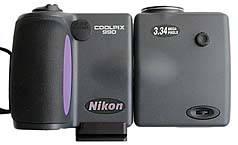 |
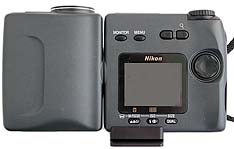 |
A continuation of the twist-and-shoot digital camera line that began with the 900, the 990 uses Sony's latest 3-megapixel CCD to capture images of up to 2048 x 1536 pixels. Since many claim, mostly correctly, that you only need 150 dpi files to print stunning images with the latest Epson photo printers (870/880, 1270/1280, 2000P), that means that the 990 should produce almost enough resolution to create 11" x 14" prints. And how many of us print anything bigger than that?
Of course, at 300 dpi we're down to a 5" x 7" image, but with some careful Photoshop work, you can easily get an 8" x 10", and perhaps even an 11" x 14" print that doesn't reveal its digital origins.
So, for one-fifth (or less) the price of a D1, the Coolpix 990 looks very tempting. (If you comparing the 990 against previous Coolpix models, look at my review of the Coolpix 950. A Coolpix 995 review is coming soon.)
The primary things the 990 sacrifices over the D1 are:
-
Use of all the available Nikkor lenses in the F mount. Your existing 35mm lenses can be used on the D1, albeit they gain the equivalent of 1.5x the focal length; the Coolpix 990 is limited to its built-in zoom and a handful of screw-in lens converters.
- No through-the-lens goodies. The D1 features the typical SLR viewfinder, plus TTL metering and flash. The Coolpix 990 uses a point-and-shoot type optical viewfinder and an external flash sensor. You'll appreciate the D1's viewfinder when you're shooting in bright light; you'll curse the 990's color LCD when you're shooting in bright light.
- 35mm-like control. On the D1, the controls are patterned after an F100, whose chassis the D1 uses (curiously, some of the electronics, including the 1005-pixel white balance control, are derived from the F5). If you've used any recent Nikon 35mm body, the controls are right where you expect them on a D1, and learning to use the camera is a snap (pardon the pun). The Coolpix 990 has a few familiar controls, but much of the real functionality is built into a menu system navigated by a Nintendo-like keypad. This really isn't a problem to learn, but like the F70/N70's interface, it slows down shooting.
- The D1 accepts Type II CompactFlash cards, the Coolpix 990 doesn't. In other words, you can use the 360MB IBM Microdrive in the D1, but not in the 990.
- Continuous shooting can be as fast as 4.5 fps for up to 21 consecutive shots on the D1 (which I've never maxed out), but the Coolpix 990's continuous shooting mode isn't very continuous at all, and I've often found myself holding down the shutter release waiting for the data to be transferred to the CompactFlash card after only two shots.
- A few features go a bit further on the D1 than the 990: the self-timer is adjustable through a user-settable range on the D1 while the 990 has only two choices in delay; the shutter speeds of the D1 range from 30 seconds to 1/16,000, while the 990 is 8 seconds to 1/1000; ISO values of 800 and 1600 are allowed on the D1 (although they are noisy), but not available on the Coolpix 990.
- IEEE-1394 (Firewire) data transfer on the D1 versus USB on the Coolpix 990. In practice, that means faster data transfer using cable with the D1.
- Price! Street prices of the Coolpix 990 hoover just under the US$1000 mark, while the D1 (without lens!) checks in at five times that. (Even lower now that the 995 is out. The 990 is often found near US$800.)
- Weight and size. The 990 is only 13.8 ounces (390g) while the D1 body only is 2.5 pounds (1.1kg).
- Built in flash. Okay, the 990's flash isn't particularly useful around people, due to the nearly guaranteed redeye, but it does provide flash exposure compensation, which is great for fill flash use.
Things that are surprisingly similar on the D1 and 990:
- Resolution. The Coolpix 990 shots at 2048 x 1536 pixels while the D1 shoots 2000 x 1312 (the D1x can hit as high as 4008 x 2624 using Bibble). Score one for the 990 (or the D1x). The D1 can store 12-bit raw data files (the 990 is 8-bit). Score one for the D1 (assuming you've got the storage space and the optional software to use them).
- Operating modes. Both sport matrix, centerweighted, spot, or AF spot metering. Both have program, aperture-preferred, shutter preferred, and manual exposure modes. Both allow you to customize white balance. Both sport autofocus or manual focus. Both support auto bracketing, exposure compensation, and flash exposure compensation. Indeed, both support virtually all controls that a sophisticated amateur or professional photographer would expect.
- An annoying sub-2" color LCD for previewing, reviewing, and making menu options. Neither is very viewable in bright light, though the D1's is a tad bit better. Both color LCDs do not show the entire frame. The Coolpix 990 shows 97% coverage, the D1 cuts off the extreme right and left edges (hey, just like trying to print a 35mm negative on 4:3 ratio paper!). (The D1x and D1h show 100%.)
The bottom line is this: if you can live without the interchangeable lenses, a professional-level build quality, and a few features at the extremes, the Coolpix 990 is probably a better choice for 35mm shooters wanting to experiment with digital.

![]() Laminated
Depth of Field cards for the Coolpix 990. You get two cards, one for
the wide angle position, one for the telephoto position. Both cards have
near/far focus points for all apertures at seven different focus distances
(in feet and in meters), PLUS hyperfocal distances for each aperture.
The US$9.95 price includes shipping in the US and Canada.
Laminated
Depth of Field cards for the Coolpix 990. You get two cards, one for
the wide angle position, one for the telephoto position. Both cards have
near/far focus points for all apertures at seven different focus distances
(in feet and in meters), PLUS hyperfocal distances for each aperture.
The US$9.95 price includes shipping in the US and Canada.

The Basics
You've already learned about some of the major features, but let's take a closer look:
The Coolpix 990 is light (18.8 ounces, 390g without batteries) and reasonably small (longest dimension is 5.9 inches, 149mm). Like the Coolpix 900 and 950 it replaced, the 990 features Nikon's unique twist-and-shoot body. For those who haven't seen this in action, the body is split into two halves whose connection allows you to rotate one in relation to the other. This is more convenient and useful than it sounds (see handling).
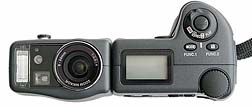
You power the 990 with 4 AA batteries or an optional AC adapter (which inconveniently plugs into the front edge near the top of the camera; watch for cables in your shots if you shoot using the AC adapter). Battery consumption is better than the Coolpix 950, but still, buy several sets of Nimh rechargeable batteries, as you'll be changing batteries as often as every 60 minutes of continuous use, especially if you're using the color LCD to compose photos.
You'll be wanting to use the color 1.8", 110,000-pixel color LCD to compose your shots if critical framing is an issue, or if you're using any of the accessory lens converters (fisheye, wide angle, and two telephoto converters are available). That's because the optical viewfinder only shows 85% of the image, and is blocked by the optional lens converters. The color LCD--if you can see it--shows 97% of the frame. On the plus side, the optical viewfinder has a -2 to +1 diopter adjustment and is close enough to the lens that parallax is only a problem at close distances. The optical viewfinder zooms to match the built-in lens, and AF and flash confirmation LEDs are easily visible without taking your eye from the viewfinder. Lens wearers can see the entire frame (at least I can).
The lens is a 8-24mm Nikkor (that's equivalent in angle of view to a 38-115mm in the 35mm world; Coolpix 950 users will wonder why the focal lengths are different, but the equivalents are the same; this is explained by the difference in the size of the CCD sensors in the two cameras). At the wide end, the lens opens to f/2.5. At the telephoto end, the variable aperture lowers this to f/4. You'll see some apertures you've never seem before (f/4.3 anyone?) when you choose aperture priority, and the lens only closes down to a little over f/11. The lens itself is mostly worthy of the Nikkor name (and uses 9 glass elements in 8 groups), producing barrel distortion at the wide end and exhibiting a fair amount of chromatic aberration. If you don't mind ugly artifacts, there's a 4x digital zoom effect that produces Big Pixels (if you really must blow up a portion of the frame, save the image using the Genuine Pixels software supplied with the camera, and/or use PhotoShop's sizing controls).
You get 4896-step autofocus from 11.8" (30cm) to infinity, which is way overkill due to the deep depth of field the small sensor produces. In macro mode, the lens focuses as close as 0.8" (2cm). An infinity focus function is available, but it's really a hyperfocal focus. You can also choose one of 50 manual focus points (up from the 10 in the Coolpix 950).
Now that you've read all about all those focusing abilities, forget 'em (well, the macro setting is useful). Depth of field is always quite high with this camera. You don't need 4896 autofocus settings, all they do is wear the batteries down without giving you any real control over what's in and out of focus. (If you don't believe me, plug in a focal length of 8mm and a circle of confusion of .008 into your DOF calculator and see what you get; better still, buy the laminated depth of field chart for the 990 offered in the top of the far right column in this review).
Image quality and size ranges from 640 x 480 with high JPEG compression to 2048 x 1536 uncompressed TIFF, with a wide variety of options in between. The camera is billed as being a 3-megapixel camera, which in reality is 3.34 million pixels. Like most modern digital cameras, the Nikon uses the same Sony CCD sensor every other manufacturer does. That doesn't necessarily mean two cameras from different companies with the same sensor produce the same results, though. Nikon's use seems to produce slightly lower saturation than I've seen from some other companies, but there also isn't a color cast and the results are quite sharp. Compared to the 950, the 990 seems to have slightly better color saturation and makes better white balance choices. The default sensitivity of the CCD sensor is about ISO 80, but if you don't mind spurious noise, you can manually override that to ISO 100, 160 (+1), or 320 (+2). [Note: previous versions of this review were incorrect in suggesting that the higher ISO values were 200 and 400.]
The shutter is a combination of mechanical and electronic, and offers shutter speeds from 8 seconds to 1/1000. Useful range is much more limited than that, though, as long shutter speeds tend to generate random pixel noise. While there's a mechanical shutter, I've never heard it (or felt it), so it's darn quiet (the camera defaults to a computer beep to tell you that you've taken a shot).
Photos are stored on a removable CompactFlash card. A 16MB card comes standard, though you can purchase third-party cards with capacities over over 200MBs. Unfortunately, the 990 only supports Type I CompactFlash cards, which means that the IBM 1GB Microdrive, which comes in a CompactFlash card version but requires a Type II slot, can't be used. Since the Coolpix 950 was criticized for this omission and Nikon moved the card slot to a better location on the 990, I don't understand why they stuck with only Type I cards [With the introduction of the 995, which has a Type II slot, we found out why: Nikon is worried about heat buildup from the drive.]. For each 8MBs of CompactFlash memory you can store approximately:
-
2048 x 1536 Basic -- 19 pictures
-
2048 x 1536 Normal -- 10
-
2048 x 1536 Fine -- 5
-
2048 x 1536 Hi -- 0 (one image takes over 9MBs)
-
1024 x 768 Basic -- 73
-
1024 x 768 Normal -- 38
-
1024 x 768 Fine -- 19
-
640 x 480 Basic -- 161
-
640 x 480 Normal -- 91
-
640 x 480 Fine -- 48
You can set Program (P), Aperture-priority (A), Shutter-priority (S), or Manual (M) exposure modes, but the latter three are only available when the camera is set to M-Rec (Nikon provides an all-automatic A-Rec mode and a user-adjustable M-Rec mode). White balance can be set automatically or manually. Metering is done via traditional spot, centerweighted, or 256-element matrix methods, there's also a AF spot mode that works like the spot meters in the F80/N80, F100, and F5, but which is frustrating to use in practice, since you can't tell which area the camera is using unless you switch a special function on and use the color LCD to select focus areas.
Exposure compensation can be set in a -2 stop to +2 stop range in third-stop steps. Flash exposure compensation works the same way as it does in the 35mm bodies (+1 to -3 stops). Bracketing is done in as many as five steps, with as much as a 2/3 stop difference between each.
Additional exposure and image options include a few dubious controls: Best Shot Selector (camera throws away all but what it thinks is the best image of 16), Image Sharpening (better left to the computer), plus user-adjustable Contrast and Brightness settings (again, usually better left to the computer; if you need 'em in camera, your exposure is probably wrong).
The 990 uses USB communications to Windows or Mac computers, though you can also use serial communications if you're got an older computer.
Unlike previous models, the Coolpix 990 has user-selectable NTSC (US) or PAL (Europe) video output, which enables it to display images on a television virtually anywhere in the world. A video cable is supplied with the camera. Rudimentary slideshow controls are built into the camera.
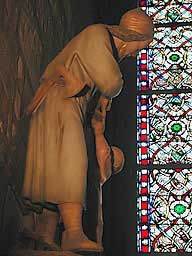
Here's a tough
situation for the Coolpix: inside the Cathedral of Notre Dame with no
flash, only ambient lighting, and that's a mix of daylight streaming through
the window, 20 watt incandescent near the statue, and some strange fluorescent
fixtures nearby. Despite the distractions, the 990 found the focus spot
off center, and exposed well enough to keep detail in both the bright
stained glass and the statue (with a little help from Photoshop levels).
Noise is low, despite the long exposure (1 second).
Handling
I wasn't a fan of the 950's handling, so it will come as no surprise that the 990 isn't my favorite in this respect, either. Fortunately, Nikon's engineers are headed in the right direction--this Coolpix model fixes a few of the strange choices that characterized the interface of the 950 and 900. Still, there's much to dislike.
Buttons have been moved around from the Coolpix 950, but most of them live on and continue to have dual (or triple) personalities. The exposure compensation and mode buttons have been moved to the top deck just like on the 35mm bodies (did some engineer win an argument here?). The Control Dial has moved from the front to the back, where it falls naturally under the thumb. A Nintendo-type control pad has been added, though you'll rarely use it for focus selection point as you do on the 35mm bodies. Instead, here you'll find it useful for navigating the menu system.
Despite being moved to more logical places, buttons still have the ability to confuse. Take the self timer control, for example. It's coupled with the Infinity and Macro focus settings. Press a button once, the camera sets Infinity focus. Press the button again to set Macro focus. Press the button again and you get...ta-dah...the self timer! Press it again, and you get regular autofocus with no self timer. And when you've set the self timer, you press the shutter release twice to set it to a shorter time (3 seconds instead of 10). And, yes, you can't set the self-timer in conjunction with Infinity or Macro focus. In M-Rec mode (why can't they just say Manual?), the button does a Dr. Jekyll--now you hold it down and turn the Command Dial to set a manual focus distance. Say what? (Think you'll remember everything in that last paragraph one month after you've last used the camera? Think again.)
Then there's the heavy reliance on the color LCD. While I like what Nikon has done to simplify parts of the menu system, there are still too many options (meaning you have to scroll through multiple pages to find a setting), and it's darn difficult to see the color LCD in daylight. It isn't exactly intuitive to press the Right Arrow pad to get to sub-options of a menu item or to lock in a setting, though once you've done it a couple of times, it'll come naturally. If you've got big fingers, you might not like the Nintendo-pad control at all, as it is small, and the right side is cut out of the curve of the body creating a ridge right next to it.
The manuals that come with the camera are quite good, among Nikon's best. I highly recommend reading them before trying to figure out what the designers were thinking. You'll almost think the controls make sense if you work your way page by page through the manuals. Almost. But you'll eventually have to use the camera in the field without a manual at your side, and then you'll be reminded just how idiosyncratic some of the design decisions really are.
Unlike the 950, the built-in flash is sometimes useful on the Coolpix 990. That's because you can control flash exposure compensation. While the wimpy range and guaranteed redeye don't make it very useful for taking pictures of people, the flash is extremely useful for providing fill on static subjects. I find that I'm dialing in less compensation than I do in 35mm (-1.0 to -1.3 instead of -1.3 to -1.7), but at least I can dial it in!
None of this is to say that the camera doesn't have positive handling attributes. If you're an automatic-only, no-extra-features-please shooter, the camera feels good in the hand and the basic controls are right where you'd expect them. The extra width of the battery cage gives your right hand something to grip, though if you've got small hands, you might find the front bulge a little on the big side. Your second finger falls naturally on the shutter release. Your thumb finds the zoom buttons and command dial without hunting. Heck, even the twist-and-shoot section on the left gives you a natural place to grip with your left hand. Click, done deal. (Well, actually the "shutter sound" is a more computer-like beep, which can be turned off if you need to use the camera in quiet situations; of course, when you turn the shutter sound off, you won't know when the camera has actually taken a picture.)
And you'll end up loving that ability to twist the lens in virtually any angle to the main controls on the right. Not only does that allow self-portraits without a tripod, but it becomes darn convenient to frame shots with the camera plastered against a wall, on the ground, or held above your head (assuming, of course, that you can see the color LCD).
Exposure
If
you're used to Nikon's metering on the 35mm bodies, you'll find the
Coolpix 990 to be spot on to what you know. Matrix metering has the
same problems with high contrast, large brightness range scenes as do
virtually every Nikon 35mm body (expect underexposure). Virtually every
normal condition is rendered with aplomb and accuracy.
Centerweighted
and spot metering are a bit tougher to use on a Coolpix than they are
on the 35mm bodies. First, the viewfinder indicators don't correspond
as well to the actual metering area. The AF spot metering mode is hidden
in the menu system and requires you to use the color LCD to select focus
and metering spots.
Focusing
Why Nikon thought it necessary to provide a 4896-step autofocus system on the Coolpix 990 escapes me, and why they increased the range by a hundred or so steps over the Coolpix 950 is even more puzzling. One photo friend chalks it all up to marketing ("hey, if Canon has 3999 steps, Nikon has to have more."). Because of the small sensor size (compared to the 35mm frame) and the corresponding short focal lengths (8-24mm!), you're going to almost always have too much depth of field to worry about whether you need Step 2836 or Step 2837. Heck, Nikon could have provided only a couple dozen steps and not really compromised the focusing performance.
That said, autofocus performance is swift. I don't find the autofocus as "twitchy" as the 950, but it'll still make lots of small adjustments that, no doubt, don't really change the depth of field one iota. The 990 includes a close-up (macro) mode that'll take you down to 8" (2cm), an "Infinity" mode, and a 50-step manual focus ability that takes a bit of study to figure out how to access and use.
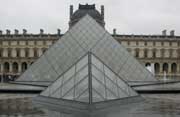
Another dull
day in Paris. Overcast, ugly lighting makes the Coolpix produce what looks
at first glance to be a poor shot.
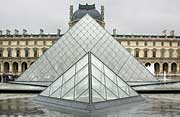
But the color
and dynamic range was really there in the image. This is one reason why
I suggest that you learn to use ICC color profiles for your digital cameras.
I think you'll be a bit surprised at just how good the images look when
the proper color space corrections are applied.

Of course,
there are other issues to deal with. Here's an enlargement from near the
top left corner. Note the purple fringe to the right of the column. Also,
you might notice some green fringing (hard to see without really blowing
up the shot) in some of the edges (look at the left edge of the column).
That's chromatic aberration, and it's very tough to get out of a shot,
though there are a few third-party filters that do a decent job.
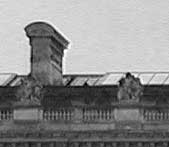
Meanwhile,
take a look at the Red channel. You'll see some noise in the sky, and
at the left edge of the column you'll see distinct JPEG artifacts. Still,
all things considered, this is remarkably good performance, and a skilled
editor with the right tools could fix all the noted problems. Go back
and look at the full shot, then check out the vertical pickets between
the gargolyes (or whatever they're called). The Coolpix 990 does a good
job of resolving small detail, though the latest pro digital cameras do
a slightly better job.
-
Extreme Light Conditions. The ISO 100 sensitivity is a little on the low side, and the camera can only shoot up to EV 15.5 at wide angle (EV 16.7 at telephoto). In bright snow or sunny conditions, that's a problem. While Nikon claims a shooting range down to EV -2, in practice you'll see objectionable noise in truly dim conditions, especially at the mechanical shutter speeds under ¼.
- Too Much Depth of Field. Even though the 990 has a slightly longer lens than the previous models, at virtually every aperture and lens position you'll find that depth of field is enormous compared to what you're used to in 35mm (see the laminated depth of field chart offer in the top right column.) (The D1 tends towards the opposite problem, by the way.) Believe me, this will have an impact on your photography, as you'll find it very difficult to get rid of distracting backgrounds.
-
Poor Battery Life. Better than previous models, but the 990 is still a voltage vampire. Invest in several sets of Nimh rechargeable batteries and always travel with extra sets of batteries.
- Restrictive Lens. A 38mm to 115mm zoom is point-and-shoot territory. Serious photographers want at least 28mm at the wide end, preferably 20mm or 24mm. Unfortunately, using the Nikon lens converters on the Coolpix 990 leaves something to be desired. While you can get close to that 24mm mark with the WC-EC24, you'll get too much barrel distortion and soft edges. Even the replacement WC-EC63 still has a bit of barrel distortion and soft edges). The telephoto converters fare better, though you'll have a poor maximum aperture (f/8 with the longest!). But all the converters restrict optical viewfinder and flash use, which is bad, bad, bad. If only Nikon had allowed something like screw-in C mount lenses...
-
Excellent Color Rendition.. I've seen digital cameras that require lots of fiddling in Photoshop to get the color balance correct. The Nikon Coolpix cameras, while not providing the most saturated color I've seen, render colors naturally and mostly neutral. Underexposure often requires color adjustment, but when the meter is dead on (which is often), you won't be tempted to tinker much with the color other than to apply an ICC profile and convert to a large color space (such as AdobeRGB).
- Detail is Very Good. If you've got an Epson 870/880, 1270/1280, or 2000P you're going to discover something unexpected: you can produce film-quality 8" x 10" photos with the Coolpix 990, perhaps even 11" x 14." .
- Web Delight. If you need to produce product or other photos for a Web site quickly and without a lot of fuss, the 990 is a good choice. If you don't need the extra features and resolution of the 990, and the 950's primary drawbacks won't get in your way for web work. Plus, the close-up mode of both cameras is great for capturing small objects and playing with macro photography (without the limited depth of field of 35mm). Many of the product shots on this site were produced using the 990 in a matter of minutes (from determination of need to final JPG).
- Control Over the Big Stuff. Need more sensitivity? Need to set a particular aperture or shutter speed? Need to use spot metering or override the camera's meter? Need to focus close? The 990 answers those basic needs (and more).
